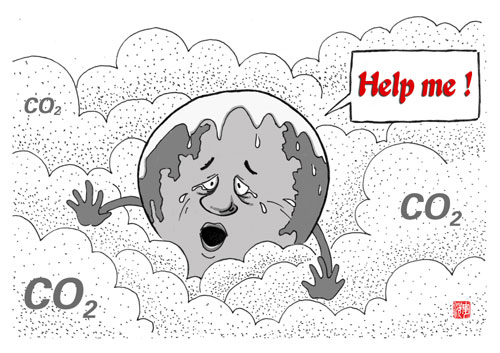China explores possibilities of low-carbon future
Updated: 2012-03-13 16:30
(Xinhua)
|
|||||||||||
BEIJING - As China tunes down its growth expectations, the Asian economic powerhouse is trying to leave itself more room to improve the way in which it grows, and a low-carbon economy is certainly among its major goals.
With the country's lawmakers and political advisors gathering to discuss future plans and possibilities, China has presented its determination to further reduce emissions and give shape to a new low-carbon scheme.
"We will show the world with our actions that China will never seek economic growth at the expense of its ecological environment and public health," said Chinese Premier Wen Jiabao in a government work report delivered during China's annual legislative session.
Carbon emission trading would be one of the major steps, as in Wen's report, the Premier pledged to start trials of such a trade system and a cap-and-trade scheme for pollution rights, and move faster toward establishing "a compensation mechanism for ecological damage."

A pilot scheme for carbon emission rights trading already launched last year in seven Chinese municipalities and provinces -- Beijing, Shanghai, Tianjin, Chongqing, Hubei, Shenzhen and Guangdong -- with a view to expanding it nationwide if the tests proved successful.
"The trading is an important means to boost energy conservation and emission reduction," said Lu Xiulu, a local economic planning official in the southern Guangdong province and a deputy to the National People's Congress (NPC), the country's top legislature.
The official said carbon trading can help China realize its emission reduction targets, as well as encourage further green initiatives being incorporated into the country's economic development and the coordination of regional modernization.
China has pledged to reduce carbon dioxide emissions per unit of GDP by 40 to 45 percent by 2020 compared to 2005 levels.
But Lu noted that China's major challenge at the moment is the establishment of emission rights, and the establishment of a trading system.
Lawmakers and political advisors have also eyed the formation of a government-led platform for international climate trading. Zhang Jiao, a political advisor from the China National Democratic Construction Association, said China should develop futures and options products for greenhouse gas emission rights that could be tradable in international markets.
"China currently has several bourses for climate trading, but they lack a standardized trading mechanism," said Zhang.
Zhang Shouquan, a political advisor from Beijing, has proposed more fiscal and taxation support for emission reduction, further reform of energy pricing mechanisms, and establishment of funds to encourage the application of low-carbon technologies and projects.
China would also employ both traditional and high-tech measures, like tree planting and low-carbon buildings.
In China, more than 92 million mu (6.13 million hectares) of land was planted with trees last year. These trees absorbed a total of 1.8 tonnes of carbon dioxide and produced more than 1.6 tonnes of oxygen in the period, said Chen Jiadong, a local forestry official from Fujian province and an NPC deputy.
Cao Hongming, a political advisor from the China Public Interest Party, is a strong supporter of low-carbon buildings.
Promoting the use of these buildings would ensure the healthy development of China's property market, as they can reduce pollution and save energy, land use, water and construction materials, Cao said.
But despite all these efforts, China, as the world's largest developing country, would stick to the principle of common but differentiated responsibilities' and play a constructive role in promoting the progress of international climate change negotiations, said Sheng Lianxi, a political advisor.
"China has a clear-cut attitude on environmental issues, that we would actively participate in the global biological diversity protection and air pollution control," said Sheng.
China's energy use per unit of GDP dropped 19.1 percent between 2006 and 2010, while energy-saving efforts helped reduce emission of carbon dioxide by 1.5 billion tonnes and saved the equivalent of 630 million tonnes of coal.
Today's Top News
President Xi confident in recovery from quake
H7N9 update: 104 cases, 21 deaths
Telecom workers restore links
Coal mine blast kills 18 in Jilin
Intl scholarship puts China on the map
More bird flu patients discharged
Gold loses sheen, but still a safe bet
US 'turns blind eye to human rights'
Hot Topics
Lunar probe , China growth forecasts, Emission rules get tougher, China seen through 'colored lens', International board,
Editor's Picks

|

|

|

|

|

|





